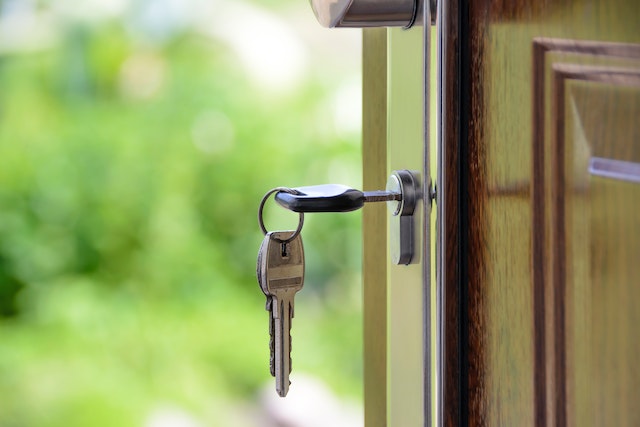
When did people first start using locks and keys? Keys and locks were first used about 6,000 years ago.
The earliest lock that has been found so far was 6,000 years old and was found in the ruins of Nineveh, the capital of ancient Assyria. The fact that a fully formed lock was discovered means that the technology must have been around since before then. The first cities appeared about 7,500 years ago, and it is probably safe to assume that people started to need locks when they started to live in larger communities. When people lived in small settlements, everyone knew everyone else. Trust seems to be inversely proportional to the number of strangers you live with. The lock found in Nineveh was in the ruins of the Khorsabad palace, so it is thought it was probably used to protect something valuable in there.
The lock that was found was made of wood and was a simple pin lock. A pin lock has holes drilled into the bolt and wooden pins rest in the holes. The door had a hole in it and someone would put their arm through the hole with a shaped piece of wood that would fit in the lock and lift the pins, freeing the bolt to be pulled out. The Egyptians improved on this by adding a key. The key was a stick with pegs that match the positions of the pins. When the correct key is inserted, the pins are lifted by the pegs on the key, and the bolt can be pulled out. These were very simple because there aren’t many combinations of pins that you can have.
The Greeks took Romans inherited locks from the Egyptians through the Greeks and then they improved on them. From about 900 BC the Romans started to make locks out of metal. They also invented a lock called a “warded lock”. Wards are specially shaped pieces of metal that are stuck just inside the mouth of the lock. The key for the lock is cut so that it can turn without hitting the wards. If the wrong key is inserted, it will hit the wards and won’t be able to turn. Egyptian locks were about 60cm long. The Romans managed to make the locks a lot smaller.
From the end of the Roman era to the Industrial Revolution, there wasn’t a lot of improvement with lock security. The shape and number of wards was increased, but that was about it. The locks looked beautiful, but they were very easy to pick.
After the Industrial Revolution, precision engineering became possible, which meant keys and locks could be more complex. In the early 18th century, not many people had anything they needed to protect and not many people used locks. Houses were usually left open. However, as more people moved into cities, there was more wealth moving around, and industries such as the banking industry took off, there was more need for secure locks.
In 1778, Robert Barron invented the double acting lever lock. This uses a set of levers that have a hole cut in them. When they are lifted to the exact height by the key, the bolt will slide through the holes. All of the levers need to be lifted to exactly the right height for the bolt to move. If they are too low or too high, the bolt won’t move. The key has notches cut on it to raise the levers to the required height. Many old churches still have this kind of lock, but they are not secure enough for insurance purposes.
The next advance was Jeremiah Chubb’s “detector lock” in 1818. This also used levers in the same way as Robert Baron’s lock, but it had a mechanism that would jam the lock in the locked position if the levers were lifted too high, preventing picking. It was called a “detector lock” because it would alter the owner to the fact that someone had tried to pick it. A regulator key was needed to reset the lock. These locks were secure for about 40 years before they were picked.
In 1848 Linus Yale Sr. and Linus Yale Jr. improved on the pin tumbler lock by using pins of different lengths. The pins were divided into two pieces and there was a spring above each one to keep them down. The pins had to be lifted to just the right height for the gaps in the pins to meet the edge of the tumbler and allow it to turn. This is basically the lock and key we use today.
It’s interesting to think that 300 hundred years ago, most people didn’t use locks and now most people use several. I have house locks, bike locks, a locker at work, and a postbox lock. What changed? Did society become less safe? Or did the lock makers make us think we needed more locks? The Industrial Revolution was a time when people flooded into the cities. Crime went up. Poverty went up. But, did we need locks? Now, most locks can be picked, but they give us the illusion of security, and I guess that is all we really want. In the future, we will have digital locks that use a thumbprint or facial recognition software, but even those will be pickable one day. The arms race between the lock makers and the lock pickers will continue. And this is what I learned today.
Sources
https://www.precision-locksmiths.co.uk/a-history-of-locks/
http://www.historyofkeys.com/locks-history/history-of-locks/
https://medium.com/keycafe/the-history-of-keys-and-locks-8869bdc0ee7f
https://www.ancient-origins.net/history-ancient-traditions/locks-and-keys-0015361
https://en.wikipedia.org/wiki/Pin_tumbler_lock
https://en.wikipedia.org/wiki/Lever_tumbler_lock
http://www.todayifoundout.com/index.php/2014/06/great-lock-controversy-1851/
